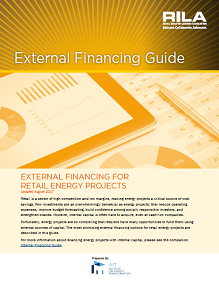Last year, the Retail Industry Leaders Association (RILA) and the Institute for Market Transformation (IMT) released two financing guides that focus on innovative ways to secure capital for energy and sustainability projects. Since that time we’ve seen the benefits of alternative financing approaches accumulate for companies like Apple, Starbucks, adidas, and LVMH. As more retailers seek ways to pay for energy and sustainability upgrades, RILA and IMT are pleased to release newly updated versions of the guides—complete with recommendations and real world examples of the latest progress made throughout the industry.
Why retailers should seize innovative energy and sustainability financing solutions
Ideally, every project with compelling financial returns could secure complete funding through a retail company’s standard project proposal process. However, retail finance teams have many strategic priorities to consider when deciding where to invest funds. Energy and sustainability projects compete with multiple departments for limited resources. That means even a highly beneficial energy efficiency project can be rejected depending on requests from other business units that may be more directly related to a company’s bottom line.
Even so, America’s retailers face high competition and low margins and sustainability projects can offer them a critical source of cost savings by reducing operating expenses and improving budget forecasting. Moreover, few other retail projects can take advantage of such a broad array of external incentives, rebates, and tax credits as energy projects in particular—or fit so well with creative internal financing solutions.
In most cases, it’s up to a company’s energy or sustainability manager to steer proposed projects to the finish line to start generating savings. To do so, they need to know what internal or external financing solutions are best suited to their particular project goals. RILA and IMT’s financing guides address this need by helping retail energy managers and finance professionals understand their options and narrow down choices to fit their company’s project parameters and risk preferences. With eleven different financing approaches explained between the two guides, there’s an approach worth considering for just about any company. And many companies are already seizing the opportunities with great success.
Apple, Starbucks unleash sustainability investments with green bonds
Last year was a fantastic launch point for green and sustainability bonds in retail. In February 2016, Apple issued $1.5 billion in green bonds and in May 2016, Starbucks issued $500 million.
Green bonds are similar to standard corporate bonds except they have funds earmarked for projects that advance energy efficiency, renewable energy, climate change mitigation, and other areas of sustainability. Both issuances showcased the variety of sustainability projects that can benefit from a green or sustainability bond.
 Since the initial issuances, it is clear both companies have found green bonds to be a powerful tool to unleash sustainability investment – so much so that they did it again. In March 2017, Starbucks issued another sustainability bond, this time an offering of 85 billion Japanese Yen. Then, in June 2017, Apple issued a second green bond worth $1 billion. In Starbucks’ case, both bonds will tackle coffee supply chain management. For Apple, proceeds will be used to further bolster spending in certain areas also addressed by their first green bond, including executing energy efficiency and renewable energy projects at its facilities, improving supply chain management, procuring safer and recycled materials for its products, and reducing the need to mine rare earth materials.
Since the initial issuances, it is clear both companies have found green bonds to be a powerful tool to unleash sustainability investment – so much so that they did it again. In March 2017, Starbucks issued another sustainability bond, this time an offering of 85 billion Japanese Yen. Then, in June 2017, Apple issued a second green bond worth $1 billion. In Starbucks’ case, both bonds will tackle coffee supply chain management. For Apple, proceeds will be used to further bolster spending in certain areas also addressed by their first green bond, including executing energy efficiency and renewable energy projects at its facilities, improving supply chain management, procuring safer and recycled materials for its products, and reducing the need to mine rare earth materials.
Green or sustainability bonds are attractive to companies such as Apple and Starbucks because a single offering can fund many projects at once across an entire portfolio. This means benefits start accumulating sooner than spreading a smaller pool of internal funding across many projects over many years. This portfolio approach also means that projects’ financing merits are viewed collectively, so an energy efficiency project bundled with supply chain or recycling projects with more uncertain returns still comfortably meet financial performance needs.
Green bonds also tend to attract new investors, which is cited as a top benefit by companies that have chosen to issue them even when internal funding would provide a lower cost of capital. Although the green bonds market is small compared to the corporate bonds market, it is growing. Last year there were $95.1 billion new issues, and the market is expected to exceed $100 billion in 2017, with some projections as high as $150 billion. The Climate Bond Initiative maintains a database of experienced green bond underwriters and third-party verifiers.
adidas’ greenENERGY Fund hits $10.8 million (€9.26 million) invested
A capital investment fund is a special budget that companies replenish annually to finance energy projects across their portfolio. Capital investment funds are designed to achieve company-wide energy and carbon reductions while also delivering a net profit for individual retail stores, which retain the energy cost savings generated by their store’s projects. Stores actively seek maintenance and efficiency opportunities to reduce operations costs, and the responsibility to identify and implement energy projects can be shared with store managers and/or store operations teams.
The adidas Group greenENERGY Fund is a capital investment fund originally created in 2012 to accelerate carbon reductions, attain and verify energy and cost savings, as well as document and share best practices across all of its facilities. Individual adidas sites submit applications for efficiency projects to the company’s Finance, Engineering, and Corporate Real Estate Steering Committee, which evaluates applications based on their projected impact on the entire portfolio of projects. adidas’ fund set a portfolio level goal of 20 percent Internal Rate of Return (IRR), allowing projects with lower returns to be pursued as long as they were balanced by projects with high returns.
As of December 2016, the fund has invested $10.8 million (€9.26 million) in 61 energy efficiency and renewable energy projects since it began in 2012 and forecasts an IRR of 29 percent across the project portfolio. The adidas Group leverages its low cost of internal capital and fosters a sharp eye for energy savings opportunities throughout its workforce.
LVMH $7.1 million (€6 million) internal carbon fund creates a virtuous GHG reduction cycle
Last year the RILA and IMT internal financing guide highlighted LVMH’s internal carbon fund, which kicked off in 2015. Structured around a real price set at 15 euros per ton of emissions, all company subsidiaries pay into a fund proportional to their carbon footprint. The funds accumulated to over $7.1 million (€6 million) by the end of 2016 and have already supported projects like the installation of LED lighting and energy consumption monitoring equipment, roof insulation, and renewable energy.
Approaches like internal carbon funds are designed to create a virtuous cycle to reduce GHG emissions. The biggest GHG emitters pay into a fund that is used to execute projects that reduce GHG emissions, meaning those departments can pay less in the future. Eventually, an increasingly smaller funding pool serves as a direct indicator that it’s working.
These are only three examples of the innovative approaches retailers are leveraging to tackle sustainability projects in ways that align with business priorities. As energy efficiency and sustainability increasingly becomes a focus, retailers should look towards the benefits of smart investment and financing.
To learn more about how retailers like these are getting creative to finance their projects and to explore what options make sense for your company, download RILA and IMT’s updated external financing and internal financing guides and use the energy efficiency finance calculator for free.
A version of this blog post appears on Greenbiz.com.

